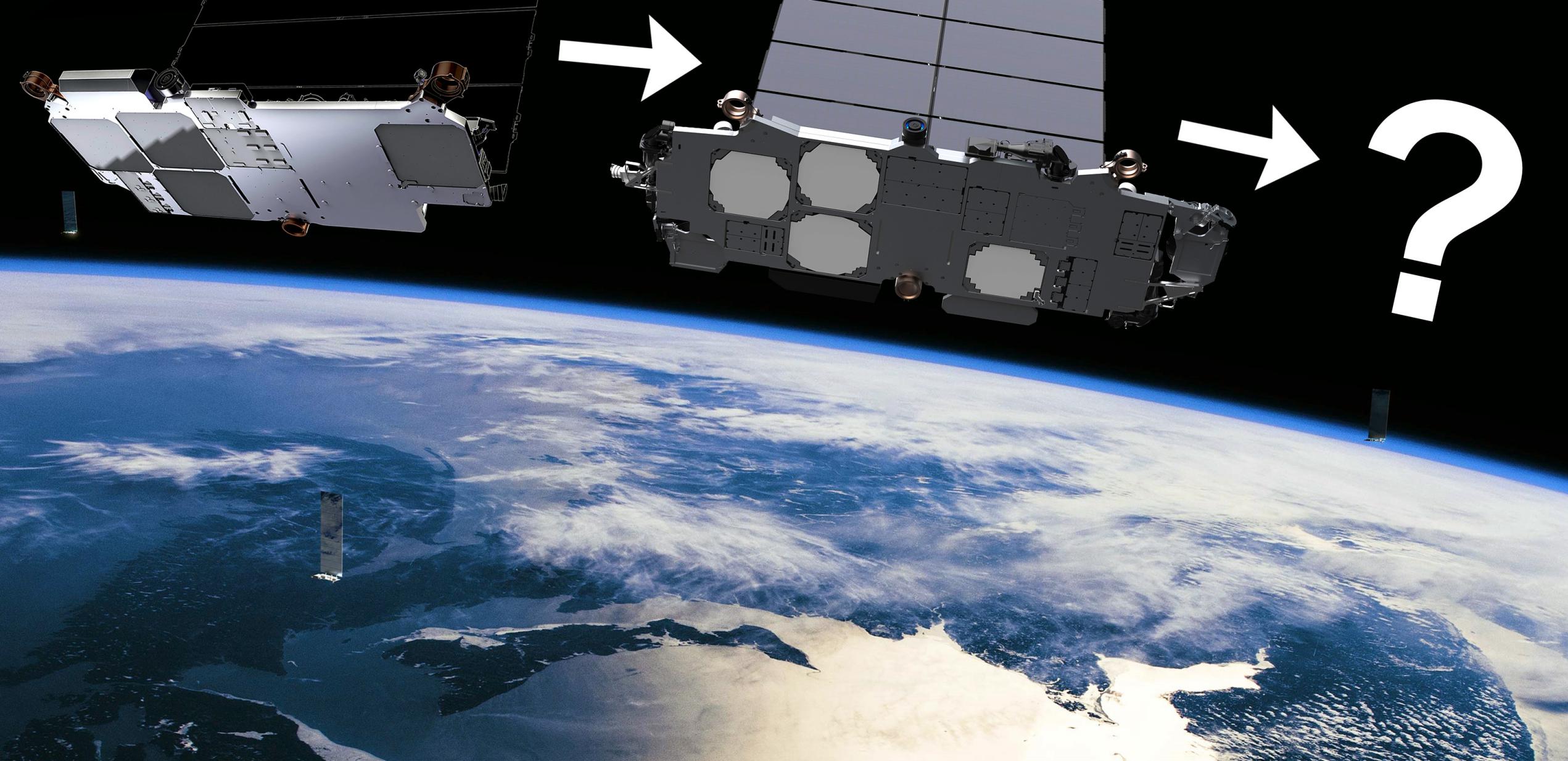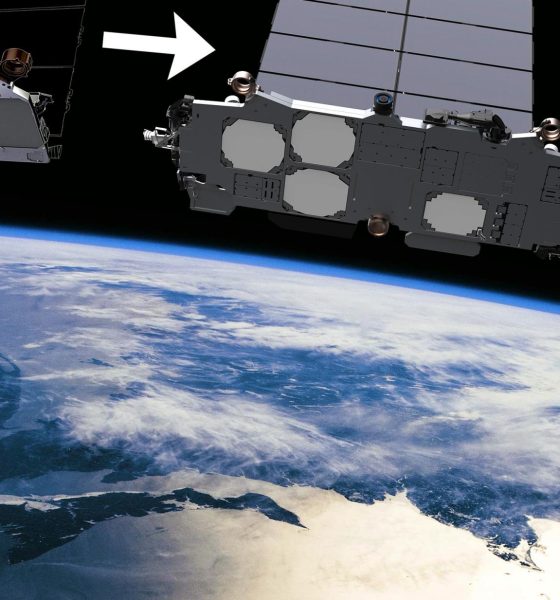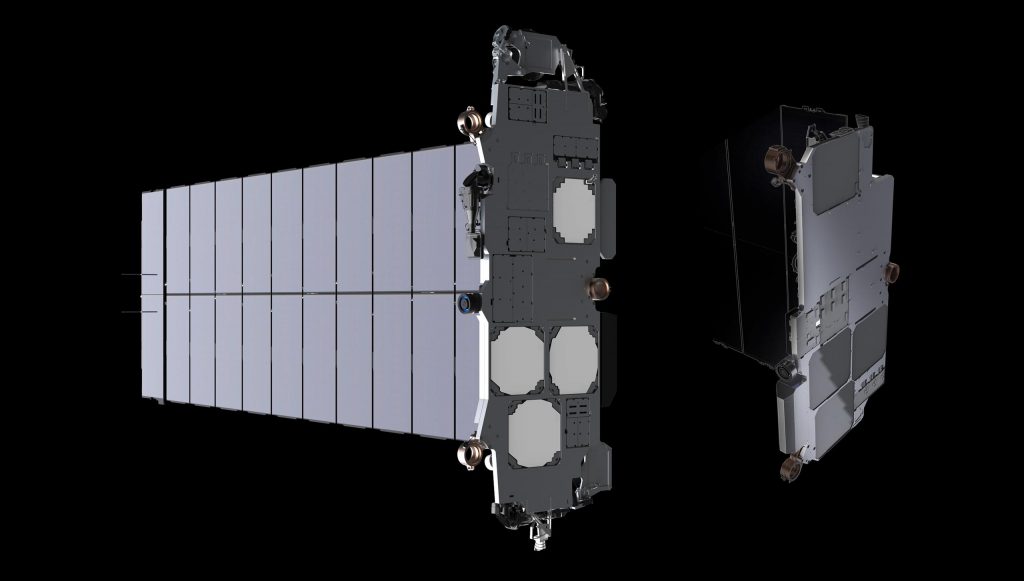

News
SpaceX CEO Elon Musk reveals next-generation Starlink satellite details
SpaceX CEO Elon Musk has revealed the first technical details about the company’s next-generation Starlink ‘Gen2’ satellite design, confirming that it will far outmatch the current generation of satellites by almost every measure.
Speaking in an onsite interview and Starbase tour with YouTuber Tim Dodd (The Everyday Astronaut), Musk – largely unprovoked – revealed that SpaceX has already built at least one functional Starlink Gen2/V2.0 satellite prototype and shipped it to the South Texas Starship factory, where it is currently being stored. More importantly, Musk also provided the first direct specifications for the next-generation spacecraft, stating that each Starlink V2.0 satellite will weigh about 1.25 tons (~2750 lb), measure about seven meters (~23 ft) long, and be almost an order of magnitude more capable than the “Starlink 1” satellites they’ll ultimately supersede.
Almost ten months after SpaceX first revealed its updated plans for a next-generation, 30,000-satellite constellation, those details have confirmed a few key points of speculation about the future of Starlink.
The 1st #SpaceX #Starlink Gen 2 #satellite has been produced. It’s 7 meters long & 1.2 tons, @elonmusk says. Note: that’s 4-5X more massive than Gen 1!
Musk adds, the new version will be almost an order of magnitude more capable than Starlink 1 in terms of useful data throughput.— Stan Shull (@stanshull) May 26, 2022
Back in August 2021, I surmised that just like it has with Falcon 9, SpaceX would again try to optimize its new Starlink V2.0 satellite design to take maximum advantage of Starship’s launch performance. In an updated Starlink Gen2 filing, the company conveniently revealed that a version of the constellation optimized for Starship would be structured such that the rocket could launch an entire orbital plane (one ring of satellites spaced evenly around the Earth) in one go. In that constellation variant, all but ~500 (1.5%) of almost 30,000 spacecraft would be stationed in planes of 110 or 120 satellites, meaning that it was safe to assume that SpaceX meant that every Starship would nominally carry 110-120 satellites. Using Musk’s latest optimistic Starship performance estimate of 150 tons to low Earth orbit (LEO), that all but guaranteed that a Starship-optimized Starlink V2.0 satellite would weigh up to 1250 kilograms.
Musk has now explicitly confirmed that each Starlink V2.0 satellite will weigh… “about one and a quarter tons” or 1250 kilograms. Starlink V1.0 and V1.5 satellites weigh around 260 and 310 kilograms, respectively, meaning that Starlink V2.0 satellites will be about a bit more than four times heavier than V1.5 and a bit less than five times heavier than V1.0.
Musk also revealed that V2.0 satellites will be “almost an order of magnitude more capable than Starlink 1.” He refused to call that capability bandwidth or throughput, the traditional method of describing a communication satellite’s total performance, but Starlink V1.0 satellites are believed to have a total bandwidth of 18 gigabits per second (18 Gbps). As of today, it’s unknown if Starlink V1.5 – a significant upgrade – also added more bandwidth, nor if Musk was referring to that latest Starlink V1.x iteration. But even if he was comparing V2.0 with the earliest V1.0 satellites, it’s possible that each Starlink V2.0 satellite could add around 140-160 Gbps to the 30,000-satellite constellation.

Ultimately, specific numbers aren’t needed to emphasize the importance of the details Musk provided. If true, they mean that Starlink V2.0 will pack roughly twice as much usable bandwidth into a given unit of satellite mass compared to V1.x. Combined with the fact that Starship could offer ~10 times as much performance to LEO as Falcon 9, a single Starship launch could theoretically expand total network capacity roughly twenty times more than one Falcon 9 launch. For example, each Falcon 9 launch of 60 260-kilogram Starlink V1.0 satellites added about 1080 Gbps of instantaneous bandwidth to the constellation. A Starship launch of 120 1250-kilogram Starlink V2.0 satellites could add around 19,000 Gbps (19 terabits per second).
Even despite those massive advantages, SpaceX’s Starlink Gen2 ambitions still leave it no slack whatsoever. If the FCC approves its license request, SpaceX would need to launch half of the constellation within six years – equivalent to around 130 Starship launches or 22 Starship launches per year. In comparison, Falcon 9 – a rocket that’s ten times smaller, less reusable, and has been flying since 2010 – did not achieve 22 launches in one year until 2020. For Starship to have any hope of achieving the cadence Starlink Gen2 requires, SpaceX would have to ramp up launches of the largest rocket ever built at a truly miraculous pace and suffer very few failures or setbacks along the way.
As immense as the challenge may be, the potential rewards are just as high. A constellation of 30,000 Starlink V2.0 satellites – if spaced evenly around the Earth – could have a total bandwidth of ~1250 terabits per second (Tbps) available over land (excluding Antarctica) at any given second. Even if half of that bandwidth is needed for backhaul and routing, the total installed bandwidth of global internet infrastructure was estimated to be 600 Tbps in 2020. Starlink will always be bottlenecked by the number of satellites that can be simultaneously available over any single point on Earth, so the constellation will never be able to match a ground network 1:1 with the same installed capacity, but it’s safe to assume that Starlink Gen2 could serve tens or even hundreds of millions of users located anywhere on Earth if SpaceX is able to build it.

News
Tesla Full Self-Driving v14.2 – Full Review, the Good and the Bad

Tesla rolled out Full Self-Driving version 14.2 yesterday to members of the Early Access Program (EAP). Expectations were high, and Tesla surely delivered.
With the rollout of Tesla FSD v14.2, there were major benchmarks for improvement from the v14.1 suite, which spanned across seven improvements. Our final experience with v14.1 was with v14.1.7, and to be honest, things were good, but it felt like there were a handful of regressions from previous iterations.
While there were improvements in brake stabbing and hesitation, we did experience a few small interventions related to navigation and just overall performance. It was nothing major; there were no critical takeovers that required any major publicity, as they were more or less subjective things that I was not particularly comfortable with. Other drivers might have been more relaxed.
With v14.2 hitting our cars yesterday, there were a handful of things we truly noticed in terms of improvement, most notably the lack of brake stabbing and hesitation, a major complaint with v14.1.x.
However, in a 62-minute drive that was fully recorded, there were a lot of positives, and only one true complaint, which was something we haven’t had issues with in the past.
The Good
Lack of Brake Stabbing and Hesitation
Perhaps the most notable and publicized issue with v14.1.x was the presence of brake stabbing and hesitation. Arriving at intersections was particularly nerve-racking on the previous version simply because of this. At four-way stops, the car would not be assertive enough to take its turn, especially when other vehicles at the same intersection would inch forward or start to move.
This was a major problem.
However, there were no instances of this yesterday on our lengthy drive. It was much more assertive when arriving at these types of scenarios, but was also more patient when FSD knew it was not the car’s turn to proceed.
Can report on v14.2 today there were ZERO instances of break stabbing or hesitation at intersections today
It was a significant improvement from v14.1.x
— TESLARATI (@Teslarati) November 21, 2025
This improvement was the most noticeable throughout the drive, along with fixes in overall smoothness.
Speed Profiles Seem to Be More Reasonable
There were a handful of FSD v14 users who felt as if the loss of a Max Speed setting was a negative. However, these complaints will, in our opinion, begin to subside, especially as things have seemed to be refined quite nicely with v14.2.
Freeway driving is where this is especially noticeable. If it’s traveling too slow, just switch to a faster profile. If it’s too fast, switch to a slower profile. However, the speeds seem to be much more defined with each Speed Profile, which is something that I really find to be a huge advantage. Previously, you could tell the difference in speeds, but not in driving styles. At times, Standard felt a lot like Hurry. Now, you can clearly tell the difference between the two.
It seems as if Tesla made a goal that drivers should be able to tell which Speed Profile is active if it was not shown on the screen. With v14.1.x, this was not necessarily something that could be done. With v14.2, if someone tested me on which Speed Profile was being used, I’m fairly certain I could pick each one.
Better Overall Operation
I felt, at times, especially with v14.1.7, there were some jerky movements. Nothing that was super alarming, but there were times when things just felt a little more finicky than others.
v14.2 feels much smoother overall, with really great decision-making, lane changes that feel second nature, and a great speed of travel. It was a very comfortable ride.
The Bad
Parking
It feels as if there was a slight regression in parking quality, as both times v14.2 pulled into parking spots, I would have felt compelled to adjust manually if I were staying at my destinations. For the sake of testing, at my first destination, I arrived, allowed the car to park, and then left. At the tail-end of testing, I walked inside the store that FSD v14.2 drove me to, so I had to adjust the parking manually.
This was pretty disappointing. Apart from parking at Superchargers, which is always flawless, parking performance is something that needs some attention. The release notes for v14.2. state that parking spot selection and parking quality will improve with future versions.
Any issues with parking on your end? 14.1.7 didn’t have this trouble with parking pic.twitter.com/JPLRO2obUj
— TESLARATI (@Teslarati) November 21, 2025
However, this was truly my only complaint about v14.2.
You can check out our full 62-minute ride-along below:
Elon Musk
SpaceX issues statement on Starship V3 Booster 18 anomaly
The incident unfolded during gas-system pressure testing at the company’s Massey facility in Starbase, Texas.

SpaceX has issued an initial statement about Starship Booster 18’s anomaly early Friday. The incident unfolded during gas-system pressure testing at the company’s Massey facility in Starbase, Texas.
SpaceX’s initial comment
As per SpaceX in a post on its official account on social media platform X, Booster 18 was undergoing gas system pressure tests when the anomaly happened. Despite the nature of the incident, the company emphasized that no propellant was loaded, no engines were installed, and personnel were kept at a safe distance from the booster, resulting in zero injuries.
“Booster 18 suffered an anomaly during gas system pressure testing that we were conducting in advance of structural proof testing. No propellant was on the vehicle, and engines were not yet installed. The teams need time to investigate before we are confident of the cause. No one was injured as we maintain a safe distance for personnel during this type of testing. The site remains clear and we are working plans to safely reenter the site,” SpaceX wrote in its post on X.
Incident and aftermath
Livestream footage from LabPadre showed Booster 18’s lower half crumpling around the liquid oxygen tank area at approximately 4:04 a.m. CT. Subsequent images posted by on-site observers revealed extensive deformation across the booster’s lower structure. Needless to say, spaceflight observers have noted that Booster 18 would likely be a complete loss due to its anomaly.
Booster 18 had rolled out only a day earlier and was one of the first vehicles in the Starship V3 program. The V3 series incorporates structural reinforcements and reliability upgrades intended to prepare Starship for rapid-reuse testing and eventual tower-catch operations. Elon Musk has been optimistic about Starship V3, previously noting on X that the spacecraft might be able to complete initial missions to Mars.
Investor's Corner
Tesla analyst maintains $500 PT, says FSD drives better than humans now
The team also met with Tesla leaders for more than an hour to discuss autonomy, chip development, and upcoming deployment plans.

Tesla (NASDAQ:TSLA) received fresh support from Piper Sandler this week after analysts toured the Fremont Factory and tested the company’s latest Full Self-Driving software. The firm reaffirmed its $500 price target, stating that FSD V14 delivered a notably smooth robotaxi demonstration and may already perform at levels comparable to, if not better than, average human drivers.
The team also met with Tesla leaders for more than an hour to discuss autonomy, chip development, and upcoming deployment plans.
Analysts highlight autonomy progress
During more than 75 minutes of focused discussions, analysts reportedly focused on FSD v14’s updates. Piper Sandler’s team pointed to meaningful strides in perception, object handling, and overall ride smoothness during the robotaxi demo.
The visit also included discussions on updates to Tesla’s in-house chip initiatives, its Optimus program, and the growth of the company’s battery storage business. Analysts noted that Tesla continues refining cost structures and capital expenditure expectations, which are key elements in future margin recovery, as noted in a Yahoo Finance report.
Analyst Alexander Potter noted that “we think FSD is a truly impressive product that is (probably) already better at driving than the average American.” This conclusion was strengthened by what he described as a “flawless robotaxi ride to the hotel.”
Street targets diverge on TSLA
While Piper Sandler stands by its $500 target, it is not the highest estimate on the Street. Wedbush, for one, has a $600 per share price target for TSLA stock.
Other institutions have also weighed in on TSLA stock as of late. HSBC reiterated a Reduce rating with a $131 target, citing a gap between earnings fundamentals and the company’s market value. By contrast, TD Cowen maintained a Buy rating and a $509 target, pointing to strong autonomous driving demonstrations in Austin and the pace of software-driven improvements.
Stifel analysts also lifted their price target for Tesla to $508 per share over the company’s ongoing robotaxi and FSD programs.








